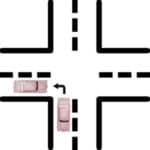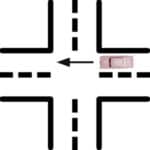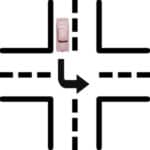A two-point turn is a basic vehicular maneuver that involves pulling into an adjacent road or drive and then backing out onto the original road to continue driving in the opposite direction.
It looks like this –



You can also pull into an adjacent street or drive on the same side of the road that you are driving on and back into the farther lane. Though, this is a somewhat more dangerous maneuver and not ideal.
Basically, a two-point turn is the simplest (and a relatively safe) way other than a legal U-turn to turn a vehicle around on the road without leaving the roadway.
How To Do a 2-Point Turn
A two-point turn is a fairly basic maneuver that involves no more than turning and backing.
To perform a 2-point turn:
1 – Look for an empty adjacent road (in residential areas, drivers often use driveways) and turn into the road or drive.
2 – Stop when the back bumper of your car is near even with the curb or side of the road.
To avoid a potential accident, make sure you pull your car entirely off the main road so cars passing on the road won’t accidentally clip your back bumper.
3 – Back into the lane you want to travel in on the main road.
4 – Drive forward in the proper direction.
How To Do a Two-Point Reverse Turn
A two-point reverse turn is exactly the same as a two-point turn, only instead of pulling off the road onto a side road to back out, you back onto the adjacent road or drive and then pull onto the main road.
It looks like this –



To perform a 2-point reverse turn:
1 – Look for an empty adjacent road (driveway).
2 – Slow as you approach the empty road or driveway and stop when your back bumper is roughly even with the far edge or curb of the road or drive you want to back into.
3 – Back onto the road or drive you are using as your turning point.
Ideally, back into the appropriate lane so your car is facing the proper direction on an adjacent road and doesn’t block the other lane. (This may be impossible on narrower roads.)
4 – Make sure you back far enough that your car is entirely off the main road and on the adjacent road or drive.
5 – Pull back out onto the main road in the direction you want to go.
Risks of a Two-Point Turn
Two-point turns are best used when there aren’t a lot of other cars on the road and there are no better places to turn around.
A country road with few businesses or houses is a prime example of where a two-point turn is the safest and best used.
When making a 2-point turn, the most important things are keeping an eye on any surrounding vehicles and making sure the roadway remains clear.
Since a two-point turn involves backing onto an active roadway or drive, you NEVER have the right of way when doing the “backing up” part of a 2-point turn. It is your responsibility to make sure both roads (or the road and drive) you are using are clear of traffic.
That said, when on a two-lane road that is too narrow for a U-turn and where there is nowhere else to turn around, the two-point turn is your best and safest driving maneuver for getting back the way you want to go.

It was really very informative. Thanks